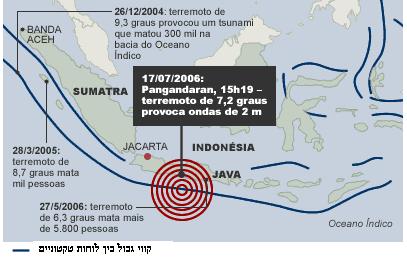July 18, 2006 - severe earthquake in Indonesia
If you meant the earthquake that occurred in Indonesia on September 30, 2009, click on this link
Avi Blizovsky and a concentration of sources

An earthquake measuring 7.7 on the Richter scale occurred on Monday in the Indian Ocean, and was accompanied by tsunami waves that killed at least 340 people on the island of Java in Indonesia. Shortly after the earthquake, a tsunami warning alarm was activated. More than 150 people are still missing, and heavy damage has been caused to resorts and fishing villages on the island. The epicenter was 360 km south of Jakarta.
Eyewitnesses reported to the news agencies about bodies floating in the sea or lying near the shore. Also, parts of a ship, uprooted trees and remains of houses were washed ashore after the water receded. "I looked at the beach and saw a high wall of water approaching. It was a black wall of water moving towards us," said a 53-year-old woman, who managed to escape before the wave hit. "I ran inside the house but got trapped in the kitchen. I couldn't go out. I was hit by things that broke and objects that were swept away with the current," she continued and explained.
The day after, it became clear that in the absence of a warning system, the messages, regarding the wave approaching the shore following an earthquake in the middle of the sea, did not reach the villages and the tourist sites on time. Authorities warned that the 7.7-magnitude earthquake could trigger a tsunami, but there is no warning system in central Java. Although the area was not affected by the deadly tsunami that hit the coast of East Asia in 2004, most residents recognized the impending disaster when they noticed the receding sea.
In some parts of the island, the waves reached hundreds of meters from the shore. The waves slammed fishing boats, cars and motorcycles into the wooden cabins of the tourist sites and fishing villages. Houses and restaurants on the beach were completely destroyed, in a densely populated strip, which is about 200 km long along the southern coast of Java.
The earthquakes caused a tsunami on the western coastline of Sumatra and Java and even on Australian beaches, according to a report by the Japanese Meteorological Agency. The seismological center in Indonesia issued a warning against tsunami waves that could be generated by the noise, later the warning was canceled, and then, earthquakes occurred.
Frightened tourists shouted "Tsunami! Tsunami!” When a wave about 2 meters high approached the shore quickly. Some climbed trees or fled to the nearby hills. The frightened villagers fled into the courtyards of the mosques and began to pray. More than 23 thousand people left their homes - some because the houses were destroyed and some out of fear of more waves.
"We saw a wall of black water. I ran holding my son, and when I looked back, I saw that the wave was destroying my house," said Ita Anita, who was on the beach with her one-year-old son and other people. "The water knocked me over and the child fell out of my hands. The water took him."
Diplomatic sources in Java told AFP that two Swedish children were among the missing. Among the injured are at least six foreigners, and one tourist from France was killed.
Earthquakes occur frequently in Indonesia, which is located in an area where seismological activity is particularly strong. Last May an earthquake killed more than 5,700 people. In the December 2004 Indian Ocean earthquake, 170,000 people were killed by high tsunami waves.
Earth scientist - natural phenomena
Drafting and editing: H. J. Glykasm, translations and technical writing
